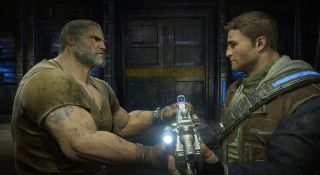Gears of War 4 is a very well considered sequel indeed. One which seems to continually take stock of the series so far, with a warm but objective eye, revisiting, retuning and reworking what is good, politely dropping the lesser successes, and ultimately crafting a finely balanced encapsulation of why those grunty, huddling gunmen were such a revolution when they first popped up from cover in 2006.
Not that it simply strips things back to basics. Rather, Gears 4 is an insightful exercise in reappraising, optimising, and consolidating. As an entry point for new players, it’s a perfect introduction to why Gears of War is important – an essence bolstered by several bold, narrative and tonal changes, but more on those later – and for old hands it’s an instant flashback to the best of Gears, but executed with freshness and vitality.
Key to all of this is the return to a smaller, two-player co-op cap, a maximum squad size of four, and a relentless focus on intimate, medium-to-close range combat. On the surface, anyway. That’s the body of Gears 4, but the soul comes in other, more subtle fine-tuning. The reconfigured friendly AI, for instance, its effectiveness (wisely) downgraded, now operates in a sweet-spot between efficiently keeping you alive with revives, and leaving the bulk of the actual combat responsibility to you and you alone. And “responsibility” is the key word.
Because with enemy health and damage output finely balanced on the tightrope between ‘Why won’t you die!?’ and absolute, ceaseless gratification each and every time they do, you’re going to have to work for every kill. You’re going to have to think about every kill – which one to make, how to most efficiently set it up, and how to reset to safety if it all goes wrong. You’re going to have to do all this as the air is thick with shifting tides of horizontal bullet-rain, and you’re going to have to do it fast. You’re always going to have to do everything fast.
Because while Gears of War 4 is ostensibly about sliding from cover to cover and delivering high-speed vivisections with high-powered weaponry, it’s actually about maths. Maths, timing, space, and constructing opportunity out of all three. Gears’ devs frequently talk about the game as a ‘horizontal platformer’, its cover spots providing safe havens by which to tactically navigate the void of no-man’s-land. But in truth, it takes just as much from fighting games and, if we’re going to get really abstract, Tetris.
Each of Gears 4’s many combat arenas is a thoughtfully arranged sequence of possible paths, risky shortcuts, and hidden-in-plain-sight secrets and bypasses, their shape and flow to be deciphered and reinterpreted on the fly as chances arise and movements are forced by the always oppressive, deceptively clever opposition. Battle is always about calculating risk vs. reward, tallying how many seconds’ fire it will take to down that priority target, vs. how much exposure you can survive, vs. how the ever-changing circumstances may cause fresh problems or open up new, better opportunities for retaliation. At its best, Gears of War 4 is a free-flowing, spatial puzzle game, where every solution is rewarded with an explosive headshot. It might be a game of bloody excesses, but it’s never a remotely mindless shooter.

But for all the intensity, Gears 4 feels a lot more open, and organically inviting, than previous games in the series. Its arenas – aside from a less successful sequence of deliberately tight environments in a middle section, which come across as slightly, unnecessarily cheap – are wider, more flowing set-ups, that feel more welcoming and less punishing than before, but which never skimp on ferocity once the fight heats up. Rather than diluting the action, they divide it into layered series of localised challenges, each linked and resonating with its neighbours, but acting as a distinct conversation in its own right.
Around these layered escalations, Gears of War 4 builds upon its new identity with subtle but pervasive tonal shifts. A new, heavy enemy class, which appears around halfway through the game, can augment its allies with health buffs, forcing immediate changes in pace and adding a whole new accent to the dialogue. New, stand-out weapons furnish new keys for the combat’s various locks, the Buzzkill’s rebounding saw blades offering multiple back-door routes to embedded targets via giddy – and occasionally hilarious – semi-controlled trickshots, while the Dropshot, which levitates an explosive, vertical drill-bit across the battlefield, can immediately solve any singular problem, provided you can safely traverse to the right position and make the time to set up the shot.
And then there are the genuinely imaginative reinterpretations of classic Gears monster encounters, which I won’t spoil, but which provide some excellent high-points in the second half of the campaign. And the creative approaches to dynamic cover, which deliver alternating safety and lethality on a moment-to-moment basis. And the new weather system, whose tearing cross-winds add brand new challenges to outdoor battles, just as highly mobile, roving lightning streams reveal what it’s probably like to be on the receiving end of a Hammer of Dawn strike. Gears of War 4 is constantly augmenting with new ideas, but it does so with wit and restraint, always building around the core Gears experience instead of distracting or detracting from it.

But speaking of tone, the new feel of the game’s narrative is equally important. Because things have changed a great deal, and all for the better, both in and out of the fiction. Set 25 years after the end of the Locust war, Gears 4’s world is markedly different from the Sera we knew at the end of Gears of War 3, and its heroes are shaped entirely by that change. Having only known peace-time, and lived as Outsiders, miles from the draconian CoG settlements set up to engineer humanity’s resurgence, they’re warm, carefree, youthful, and – shock – optimistic. Del, Kait, and JD ‘son of Marcus’ Fenix play out like genuine friends, their interactions full of familiarity, humour and care. They’re an easy bunch to immediately like, and so Gears 4 itself follows suit. And that’s only exacerbated by the arrival of a certain curmudgeonly dad. Marcus hasn’t changed, but in this new narrative ecosystem he’s now as much a force for comedy-by-juxtaposition as he is of grit or drama.
As such, Gears 4’s story mirrors its reinvigorated combat, being the product of dependable familiarity reshaped with zest and playful flair. In fact it’s at times laugh-out-loud funny. Where previously the – unintentional – comic high-point of the series was Marcus’ deadpan proclamation that “They’re sinking cities with a giant worm!” in Gears 2, this Gears of War is a game that seems to know exactly why the giant worm was so funny, a game happy to subtly acknowledge and play with the series’ tropes and excesses, but crucially without ever lapsing into alienating parody or ironic nudge-winks.
So the campaign then – a few small irritations, and a slightly truncated finale aside – is a resounding success, packed with good ideas but smartly underplayed in its execution. And so it’s very pleasing that, although not quite as creatively exciting, multiplayer and the co-op survival Horde mode largely follow suit. The core gameplay hasn’t changed, but the modes that shape it bring some mighty engaging new spins.

In terms of PvP, the big new ‘serious’ mode is Escalation, a traditional Gears team deathmatch that allows the losing team of each round to place a power-weapon of their choice on the map in one of several prescribed locations. This simple tweak opens up a raft of cunning tactical possibilities, as well as maintaining a knife-edge tension in its back-and-forth balance. Do you put the heavy weaponry near your own team’s spawn, knowing that mirrored drop locations might give the opposition the same advantage? Do you put it further out, creating an immediate choke-point with the hope of using the new gun as bait to draw out the other team? It’s a gratifyingly meaty mode, where the strategy only starts on the battlefield.
Less conceptual, but possibly more exciting, is Dodgeball, which puts downed team-mates into a respawn queue, each player only brought back into the fray when their living compatriots score another kill. It’s a glorious exercise in seesaw pressure, with camaraderie and clutch-saves aplenty as plucky last survivors turn the tide against often seemingly-impossible odds.
And on the silly end of the spectrum, there’s Arms Race, a variant of Call of Duty’s Gun Game, where everyone starts with a Boomshot grenade launcher, and all players have their weapon simultaneously downgraded to the next tier below upon every third kill scored. Without warning. Often while lining up a shot. Until both teams are running around with Boltok pistols, desperately trying to score headshots. It’s a ridiculous, goofy mode, whose randomness ensures a total lack of performace-anxiety. It’s hardly strategic, and isn’t likely to win over the hardcore eSports crowd, but as laugh-fuelled bout of stress relief it’s ideal.

As for Horde, the big new change is the Fabricator, a magic box capable of spawning all manner of upgradable, defensive objects, from barb-wire fences to automated gun turrets, as long as your team holds the currency to fuel it. Freely placeable on the map at the start of the game, the Fabricator formalises Horde’s traditional base-defence game brilliantly, turning it into something even more satisfyingly tactical. You no longer simply have to think about choke-points and survival. Now there’s the meta-layer of reshaping the battlefield to your own advantage, building up tower-defence style death corridors over multiple waves.
And another layer on top of that, as you scramble to reconcile the very limited currency collection and rebuild time between rounds with the need to place and repair equipment before the next wave begins its onslaught. And another, as ‘soft’ character classes – from sniper, to front-line soldier, to engineer – offer upgradable passive buffs for different roles. Did I mention that the scout class gets double Fabricator currency for every pick-up from an enemy corpse? And that only the engineer starts with the all-important repair tool? Yeah, that’s a killer.
Gears of War 4 is a focused, confident exercise in how to relaunch a franchise. As effective as a direct sequel as it is a soft-reboot, it’s a game crafted of thought, wisdom, and objective calculation blended with a real passion for finding the fun. It may err slightly on the safe side in its campaign, but it does so understandably, in order to strip the series back to what matters, and re-evolve it with a carefully considered outlook. A great game in its own right, the potential it implies as a launch pad for the next phase of Gears of War is just downright exciting.


